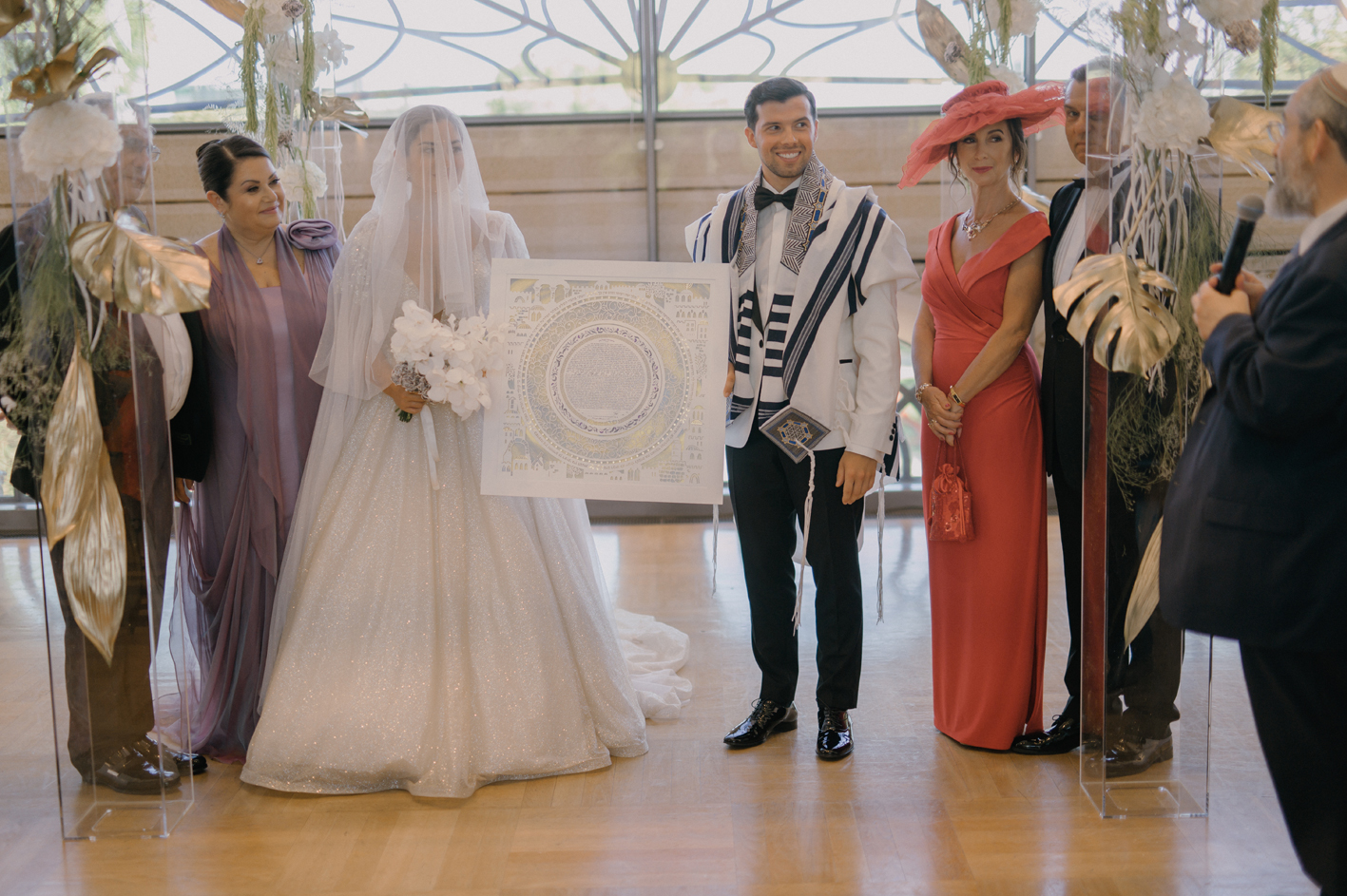The article explores the significance and role of the Ketubah in Israeli weddings, a document that transcends legal obligations, standing as a symbol of love and commitment. It delves into its history, its transformation over time, and its role in contemporary Israeli weddings, highlighting how it continues to be a cherished tradition in Jewish nuptial rites.
The Ketubah: A Brief History
The Ketubah, a sacred document in Jewish weddings, has a rich history dating back centuries. Its origins can be traced to ancient Jewish traditions and customs, making it an integral part of the wedding ceremony. The word "Ketubah" itself means "written" in Hebrew, highlighting its importance as a written contract between the bride and groom. It serves as a testament to the commitment and responsibilities of both parties in the marriage.
Throughout history, the Ketubah has undergone various changes and adaptations to reflect the societal and cultural contexts of different Jewish communities. In ancient times, the Ketubah primarily focused on the financial obligations of the husband towards the wife. However, over time, its content expanded to include provisions for the wife's rights, protection, and support. This evolution demonstrates a shift towards a more egalitarian understanding of marriage in Jewish communities.
The Ketubah also holds religious significance, as it is seen as a sacred covenant between the couple and God. It symbolizes the couple's commitment to creating a home based on love, respect, and the fulfillment of Jewish values. The text of the Ketubah often includes blessings and prayers for the couple's future together, emphasizing the spiritual aspect of their union.
In addition to its religious and legal aspects, the Ketubah is also a work of art. It is traditionally adorned with intricate designs, calligraphy, and decorative elements that reflect the cultural aesthetics of the Jewish community. This artistic aspect adds beauty and symbolism to the document, making it a cherished keepsake for the couple.
Overall, the Ketubah is a testament to the enduring traditions and values of Jewish weddings. Its history showcases the evolution of Jewish marital customs and the changing roles and rights of spouses. As couples continue to celebrate their love and commitment in Israeli weddings, the Ketubah remains a cornerstone of the ceremony, embodying the deep-rooted traditions and spirituality of Jewish culture.
What exactly is a Ketubah?
A Ketubah is a legal and religious document that outlines the rights, responsibilities, and obligations of the bride and groom in a Jewish wedding. It is often considered one of the most important elements of the ceremony, symbolizing the commitment and love between the couple. To understand the significance of a Ketubah, it is essential to explore its key components, purpose, and traditional elements.
- 1. Components of a Ketubah:
A Ketubah typically contains several key components. It begins with an introductory statement, followed by the names of the bride and groom, their parents' names, and the date and location of the wedding. The document then outlines the financial obligations of the groom towards the bride, including the amount of the dowry or bride price. It may also include provisions for the wife's support, protection, and rights in the marriage. Additionally, the Ketubah usually includes blessings and prayers for the couple's future together. - 2. Purpose of a Ketubah:
The primary purpose of a Ketubah is to establish a legal and binding agreement between the couple. It serves as a contract that outlines the terms of the marriage, ensuring that both parties are aware of their rights and responsibilities. The Ketubah also serves as a symbol of the couple's love and commitment, as it is signed by witnesses and displayed prominently during the wedding ceremony. It is a tangible reminder of the promises made by the couple and their commitment to upholding Jewish values in their marriage. - 3. Traditional Elements of a Ketubah:
Traditionally, a Ketubah is written in Aramaic, a language that was commonly spoken during the time of its origins. However, in modern times, it is also common to find Ketubahs written in Hebrew or a combination of Hebrew and English. The text of the Ketubah is often adorned with decorative designs, such as floral motifs or illustrations of Jerusalem, adding an artistic element to the document. Many couples also choose to personalize their Ketubahs by incorporating their own vows or meaningful quotes.
"Love is the greatest law": The Role of the Ketubah in Israeli Weddings
The Ketubah plays a central role in Israeli weddings, emphasizing the importance of love and commitment in the union between a bride and groom. In Jewish tradition, love is considered the foundation of a successful marriage, and the Ketubah serves as a reminder of this fundamental principle. It serves as a tangible testament to the couple's shared values, promises, and dedication to building a life together. The Ketubah is often read aloud during the wedding ceremony, serving as a powerful declaration of the couple's love and their intention to honor and cherish one another. It is a moment that symbolizes the beginning of their journey as a married couple.
Furthermore, the Ketubah also has legal implications in Israeli weddings. It outlines the financial responsibilities and obligations of both parties, ensuring that the rights of the husband and wife are protected. By signing the Ketubah, the couple acknowledges their commitment to fulfilling these obligations and promises. It serves as a contract that establishes the framework for their marriage, helping to ensure a harmonious and balanced relationship.
Beyond its legal and contractual significance, the Ketubah holds deep emotional value for the couple. It is often beautifully designed and displayed prominently in the couple's home, serving as a constant reminder of their love and commitment. The Ketubah serves as a symbol of the couple's shared aspirations, dreams, and visions for their future together.
How has the Ketubah evolved over time?
Over time, the Ketubah has undergone significant changes and adaptations to reflect the evolving nature of relationships and societal norms. Originally, the Ketubah was a simple document outlining the husband's financial obligations to his wife. However, as the institution of marriage has evolved, so too has the Ketubah.
One notable change is the inclusion of egalitarian language and gender-neutral terms in modern Ketubahs. This shift reflects the changing dynamics of relationships and the recognition of equality between partners. Instead of solely focusing on the husband's responsibilities, the modern Ketubah often emphasizes the shared responsibilities and commitments of both partners.
Another evolution in the Ketubah is the inclusion of personalization and customization options. Couples now have the opportunity to work with artists and calligraphers to create a Ketubah that reflects their unique love story and values. From incorporating meaningful symbols and artwork to selecting specific texts and blessings, the Ketubah has become a personalized expression of the couple's relationship.
Furthermore, the language and content of the Ketubah have also adapted to accommodate interfaith and same-sex marriages. Inclusive language and texts are now available to ensure that all couples can find a Ketubah that resonates with their beliefs and identities.
In addition to the textual changes, the physical appearance of the Ketubah has also transformed. While traditional Ketubahs were often plain and simple, modern versions are now beautifully designed with intricate artwork and typography. Couples can choose from a variety of styles and aesthetics to find a Ketubah that aligns with their personal taste and wedding theme.
Why is the Ketubah still relevant today?
The Ketubah remains relevant today for several reasons. First and foremost, it serves as a legal and binding contract between the couple, outlining their rights and responsibilities in the marriage. It provides a sense of security and clarity, ensuring that both partners are aware of their obligations and entitlements. This is especially important in an era where the dynamics of relationships and family structures have become more diverse.
Additionally, the Ketubah holds great symbolic value. It represents the commitment and love shared between the couple, serving as a tangible reminder of their vows. By signing the Ketubah, the couple acknowledges the significance of their union and the promises they make to each other. It acts as a sacred document that witnesses the beginning of their marriage journey.
The Ketubah also plays a role in preserving tradition and cultural heritage. It is deeply rooted in Jewish customs and rituals, reflecting the importance of marriage within the Jewish community. By incorporating the Ketubah into their wedding ceremony, couples honor their heritage and maintain a connection to their ancestors. It is a way of passing down traditions from generation to generation and ensuring their continuity.
Furthermore, the Ketubah fosters open communication and mutual understanding between partners. It encourages couples to have important conversations about their expectations, values, and goals for their life together. By discussing and negotiating the terms of the Ketubah, couples can establish a foundation of trust and a shared vision for their future.
Finally, the Ketubah serves as a testament to the celebration of love. It is not just a legal document but a beautiful expression of the couple's commitment to each other. It encapsulates the joy and excitement of their wedding day and becomes a cherished memento that can be displayed in their home, reminding them of the love they pledged to one another.
What does a Modern Israeli Ketubah Look Like?
In modern Israeli weddings, the Ketubah has evolved to reflect contemporary aesthetics and personal expressions of the couple. While traditional Ketubahs were often written in Aramaic or Hebrew and featured intricate calligraphy, modern Israeli Ketubahs embrace a range of artistic styles, languages, and designs.
With the advancement of technology, couples now have the option to customize their Ketubahs online, selecting from a myriad of templates, fonts, and colors. They can incorporate meaningful symbols, such as images of nature, Jerusalem, or the couple's favorite hobbies. Some couples even choose to include photographs of themselves, adding a personal touch to the document.
Apart from the visual elements, the content of a modern Israeli Ketubah has also evolved. While the traditional Ketubah focused primarily on the husband's responsibilities, modern Ketubahs emphasize the equal partnership of both spouses. They often include language that reflects the couple's shared values, commitments, and aspirations for their marriage.
Moreover, modern Israeli Ketubahs are increasingly inclusive and accommodating to diverse couples. Same-sex couples, interfaith couples, and those with non-traditional family structures can find Ketubahs that are tailored to their specific needs and beliefs. This inclusivity reflects the changing societal norms and the celebration of love in all its forms.
In addition to the physical Ketubah document, many couples also choose to have a digital version or artwork that can be displayed in their home. This allows them to showcase their Ketubah as a piece of art, capturing the essence of their love story and serving as a constant reminder of their commitment.
Can the Ketubah be a Bridge to Understanding Jewish Wedding Traditions?
The Ketubah serves as a fascinating window into the rich and ancient traditions of Jewish weddings. It not only symbolizes the legal and moral obligations of marriage but also holds deep cultural and religious significance. By exploring the Ketubah, non-Jewish individuals can gain a deeper understanding of Jewish wedding customs and traditions.
One key aspect of the Ketubah is its connection to Jewish law and the importance of commitment in Jewish marriages. The Ketubah outlines the responsibilities of both the husband and wife, emphasizing the principles of love, respect, and mutual support. This emphasis on equality and partnership can be a valuable lesson for individuals from all backgrounds.
Furthermore, the Ketubah reflects the importance of community in Jewish weddings. The document is often signed by witnesses who are present at the wedding ceremony, symbolizing the communal support and affirmation of the marriage. This communal aspect highlights the significance of family and community in Jewish culture and can foster a sense of inclusivity and togetherness.
Additionally, the Ketubah incorporates elements of Jewish spirituality and faith. It often includes blessings and prayers for the couple's happiness, prosperity, and well-being. This connection to spirituality can provide insight into the role of religion in Jewish weddings and the significance of faith in sustaining a meaningful and fulfilling marriage.
Israel's wedding tradition of the Ketubah is not just a mere contract, but a celebration of love and commitment. Despite the changes over the centuries, it has retained its essence, reflecting the enduring values of the Jewish faith. As long as these traditions are upheld, the Ketubah will continue to be a significant symbol of love in Israeli weddings.
https://noaattias.com/




